Toyota Prius Gen2 Board: Difference between revisions
m Made and added some new wire coloring pinouts |
m Added an extra column for harness-side wiring colors |
||
| Line 24: | Line 24: | ||
|- | |- | ||
! Pin # !! Designation !! Description!!Wire Color | ! Pin # !! Designation !! Description!!Wire Color | ||
(Inverter Side) | |||
!Wire Color | |||
(Harness Side) | |||
|- | |- | ||
|1||||vacant|| | |1||||vacant|| | ||
| | |||
|- | |- | ||
|2||GIVA||MG1 Phase Current V||LightGreen | |2||GIVA||MG1 Phase Current V||LightGreen | ||
| | |||
|- | |- | ||
|3|| GIVB ||MG1 Phase Current V|| Purple-Red | |3|| GIVB ||MG1 Phase Current V|| Purple-Red | ||
| | |||
|- | |- | ||
|4|| GUU ||MG1 PWM U - Speed Signal Wave||Blue | |4|| GUU ||MG1 PWM U - Speed Signal Wave||Blue | ||
| | |||
|- | |- | ||
|5|| GVU ||MG1 PWM V - Speed Signal Wave||Blue-Red | |5|| GVU ||MG1 PWM V - Speed Signal Wave||Blue-Red | ||
| | |||
|- | |- | ||
|6|| GWU ||MG1 PWM W - Speed Signal Wave||Yellow | |6|| GWU ||MG1 PWM W - Speed Signal Wave||Yellow | ||
| | |||
|- | |- | ||
|7|| MIVA || MG2 Phase Current V ||LIghtGreen-Black | |7|| MIVA || MG2 Phase Current V ||LIghtGreen-Black | ||
| | |||
|- | |- | ||
|8|| MIVB ||MG2 Phase Current V||Purple-Yellow | |8|| MIVB ||MG2 Phase Current V||Purple-Yellow | ||
| | |||
|- | |- | ||
|9|| MUU ||MG2 PWM U - Speed Signal Wave|| Blue-Black | |9|| MUU ||MG2 PWM U - Speed Signal Wave|| Blue-Black | ||
| | |||
|- | |- | ||
|10|| MVU ||MG2 PWM V - Speed SIgnal Wave|| Blue-Yellow | |10|| MVU ||MG2 PWM V - Speed SIgnal Wave|| Blue-Yellow | ||
| | |||
|- | |- | ||
|11|| MWU ||MG2 PWM W - Speed Signal Wave|| Yellow-Black | |11|| MWU ||MG2 PWM W - Speed Signal Wave|| Yellow-Black | ||
| | |||
|- | |- | ||
|12|| VH ||Inverter Capacitor Voltage||Purple | |12|| VH ||Inverter Capacitor Voltage||Purple | ||
| | |||
|- | |- | ||
|13|| CPWM ||Boost converter PWM switch signal||Blue | |13|| CPWM ||Boost converter PWM switch signal||Blue | ||
| | |||
|- | |- | ||
|14|| GSDN ||MG1 Shutdown||Green-Red | |14|| GSDN ||MG1 Shutdown||Green-Red | ||
| | |||
|- | |- | ||
|15|| VL ||Boost converter input voltage||Purple-White | |15|| VL ||Boost converter input voltage||Purple-White | ||
| | |||
|- | |- | ||
|16|| GINV || Inverter Ground ||Black-White | |16|| GINV || Inverter Ground ||Black-White | ||
| | |||
|- | |- | ||
|17||||vacant|| | |17||||vacant|| | ||
| | |||
|- | |- | ||
|18|| GIWA ||MG1 Phase Current W||Grey | |18|| GIWA ||MG1 Phase Current W||Grey | ||
| | |||
|- | |- | ||
|19|| GIWB || MG1 Phase Current W ||Grey-Black | |19|| GIWB || MG1 Phase Current W ||Grey-Black | ||
| | |||
|- | |- | ||
|20|| CT ||Boost converter temperature sensor||Brown-Black | |20|| CT ||Boost converter temperature sensor||Brown-Black | ||
| | |||
|- | |- | ||
|21|| GIVT ||MG1 Inverter Temperature||Green-Black | |21|| GIVT ||MG1 Inverter Temperature||Green-Black | ||
| | |||
|- | |- | ||
|22|| GFIV ||MG1 Inverter Fail||White-Grey | |22|| GFIV ||MG1 Inverter Fail||White-Grey | ||
| | |||
|- | |- | ||
|23|| MIWA ||MG2 Phase Current W||Grey-Green | |23|| MIWA ||MG2 Phase Current W||Grey-Green | ||
| | |||
|- | |- | ||
|24|| MIWB ||MG2 Phase Current W||Grey-Red | |24|| MIWB ||MG2 Phase Current W||Grey-Red | ||
| | |||
|- | |- | ||
|25|| MSDN ||MG2 Shutdown||Brown | |25|| MSDN ||MG2 Shutdown||Brown | ||
| | |||
|- | |- | ||
|26|| MIVT ||MG2 Inverter Temperature||Green | |26|| MIVT ||MG2 Inverter Temperature||Green | ||
| | |||
|- | |- | ||
|27|| MFIV ||MG2 Inverter Fail||White | |27|| MFIV ||MG2 Inverter Fail||White | ||
| | |||
|- | |- | ||
|28|| OVH ||Overvoltage||Pink | |28|| OVH ||Overvoltage||Pink | ||
| | |||
|- | |- | ||
|29|| CSDN ||Boost converter shutdown signal||Brown-White | |29|| CSDN ||Boost converter shutdown signal||Brown-White | ||
| | |||
|- | |- | ||
|30|| FCV ||Boost converter fail signal||White-REd | |30|| FCV ||Boost converter fail signal||White-REd | ||
| | |||
|- | |- | ||
|31|| OVL ||Boost converter over voltage signal||Pink-Blue | |31|| OVL ||Boost converter over voltage signal||Pink-Blue | ||
| | |||
|- | |- | ||
|32|| GCNV ||Boost converter ground||Black-Red | |32|| GCNV ||Boost converter ground||Black-Red | ||
| | |||
|} | |} | ||
Revision as of 19:43, 22 August 2020
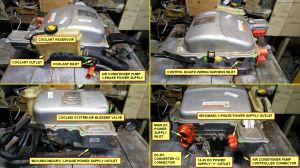

The Toyota Prius is a hybrid vehicle. Their inverters are suitable and attractive for DIY EVs because of:
- Large part availability, Prii have been made in large numbers for 20 years and spares are inexpensive.
- High affordability. Prius inverters are available for around $150 from scrapyards everywhere.
- Durability. Toyota engineers appear to have made the inverters foolproof, many inputs and outputs gracefully handle fault conditions.
- Respectable performance. Rated for 50kW output, but tested to handle 600v, and 350+A for MG2 inverter, 250+A for MG1 inverter, 360kW total (480hp).
- Ease of re-purposing. Emulating the original ECU seems reasonably feasible.
The Gen2 Prius (2004-2009 model years) has a variety of useful components inside the inverter package:
- 2 high power inverters, for the 2 motors MG1 (starter) capable of handling 250 amps, and MG2 (drive motor) capable of handling 350 amps.
- A DC-DC converter to provide 12v and up to 100amps power supply to the automotive systems and accessories.
- A tertiary power inverter to run the A/C, CAN controlled via the "BEAN" (????) network
- A boost module to boost the 200v battery pack up to 500v, which looks to be able to function as a battery charger (wish list for future development)
- See this video for a thorough disassembly and explanation of the Gen2 Inverter (Timestamp 1:15:30): https://www.youtube.com/watch?v=Y7Vm-C4MsW8&t=4531
32-pin Prius Inverter Pin mapping
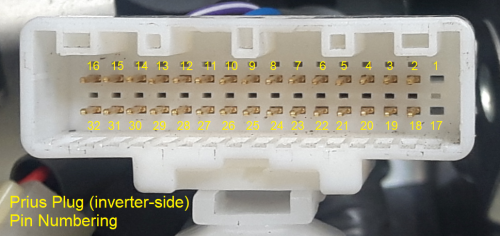
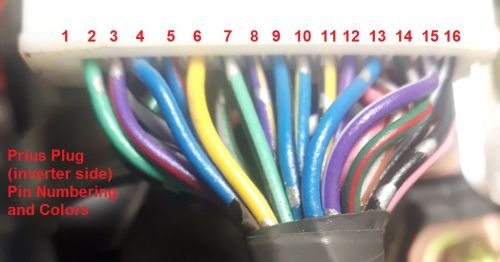
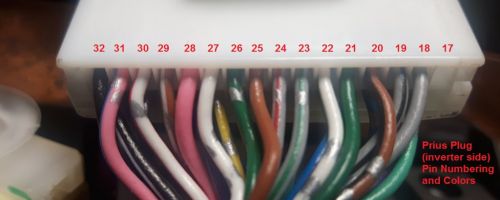
Note: Colors below are for the internal wiring
| Pin # | Designation | Description | Wire Color
(Inverter Side) |
Wire Color
(Harness Side) |
|---|---|---|---|---|
| 1 | vacant | |||
| 2 | GIVA | MG1 Phase Current V | LightGreen | |
| 3 | GIVB | MG1 Phase Current V | Purple-Red | |
| 4 | GUU | MG1 PWM U - Speed Signal Wave | Blue | |
| 5 | GVU | MG1 PWM V - Speed Signal Wave | Blue-Red | |
| 6 | GWU | MG1 PWM W - Speed Signal Wave | Yellow | |
| 7 | MIVA | MG2 Phase Current V | LIghtGreen-Black | |
| 8 | MIVB | MG2 Phase Current V | Purple-Yellow | |
| 9 | MUU | MG2 PWM U - Speed Signal Wave | Blue-Black | |
| 10 | MVU | MG2 PWM V - Speed SIgnal Wave | Blue-Yellow | |
| 11 | MWU | MG2 PWM W - Speed Signal Wave | Yellow-Black | |
| 12 | VH | Inverter Capacitor Voltage | Purple | |
| 13 | CPWM | Boost converter PWM switch signal | Blue | |
| 14 | GSDN | MG1 Shutdown | Green-Red | |
| 15 | VL | Boost converter input voltage | Purple-White | |
| 16 | GINV | Inverter Ground | Black-White | |
| 17 | vacant | |||
| 18 | GIWA | MG1 Phase Current W | Grey | |
| 19 | GIWB | MG1 Phase Current W | Grey-Black | |
| 20 | CT | Boost converter temperature sensor | Brown-Black | |
| 21 | GIVT | MG1 Inverter Temperature | Green-Black | |
| 22 | GFIV | MG1 Inverter Fail | White-Grey | |
| 23 | MIWA | MG2 Phase Current W | Grey-Green | |
| 24 | MIWB | MG2 Phase Current W | Grey-Red | |
| 25 | MSDN | MG2 Shutdown | Brown | |
| 26 | MIVT | MG2 Inverter Temperature | Green | |
| 27 | MFIV | MG2 Inverter Fail | White | |
| 28 | OVH | Overvoltage | Pink | |
| 29 | CSDN | Boost converter shutdown signal | Brown-White | |
| 30 | FCV | Boost converter fail signal | White-REd | |
| 31 | OVL | Boost converter over voltage signal | Pink-Blue | |
| 32 | GCNV | Boost converter ground | Black-Red |
DC-DC Converter
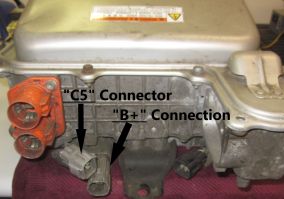
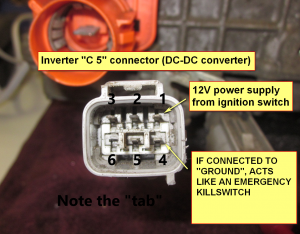
The onboard DC-DC Converter is powered by the high voltage traction battery to supply 12v and up to 100A for low-voltage automotive components and 12 battery maintenance (plays the role of a traditional alternator). Direct control of the converter is simple as only 1 wire is necessary to activate it, but a second can be added in order to enhance control.
The 6-pin "C5" connector on the inverter needs to be wired as thus:
| Pin # | Designation | Description | Wire Color |
|---|---|---|---|
| 1 | IGCT | 12v+ | Blue |
| 2 | ID1 | Not Needed | Purple |
| 3 | S | B+ (opt) | White |
| 4 | NODD | 0-5v+ | Ppl/Gld |
| 5 | VLO | Not Needed | Blue |
| 6 | Vacant |
The case of the inverter must be vehicle ground (12v battery negative terminal).
This will produce 13.2-15.2 VDC on the large C6 single-conductor connector nearby (equivalent to a car's 12v alternator positive terminal), depending on voltage applied to pin 4 (if used). No base load is required to produce voltage. Pin 4, when grounded, will act as a "KILL" input and DC-DC output will drop to zero.
Note that this output is unfused and uncontrolled and not disabled when the main inverter ignition is off (it will be on all the time unless pin 1 of the C5 connector or the HV inputs are off). It could be tied directly to the ignition switch same as the control board ignition receives (TB1-8 on the control board ... Or should that be TB1-1/TB1-2 which is controlled by ignition???), or it could have separate power-on control if desired.
Note on Limitations - As the signal to turn on the 12v converter (which converts the HV traction battery voltage down to 12v) requires some 12v power to turn itself on and IGCT draws about 6.3mA. The DC-DC system is not designed to charge up a low 12v battery and certainly not one that's completely dead. Doing so can damage the inverter/converter.
Inverter Cooling
Inverter coolant enters at the front and exits the rear of the inverter housing from the o-ring port connected to the Hybrid Synergy Drive (HSD) cooling system reservoir.
Through Hole Control Board

The Toyota Prius Gen2 Board is an open source project to repurpose 2004-2009 Toyota Prius inverters for DIY EV use. It consists of a circuit board and programming that replaces the original logic board, connected to the inverter and allows independent control of it without communicating with a Prius ECU.
Note that there is also a Toyota Prius Gen3 Board for the 2010-2015 model years.
As designed by Damien Maguire, the open source hardware for the control board can be purchased as blank, unpopulated boards on his website: Prius Gen2 Logic Board on EVBMW's Webshop
How To Use
The Prius Gen2 Board is suitable to control any (please add: motor types here) motors.
Note: There is a mistake in the printing on the v1 circuit board. The parts labelled T1, T2, and T3 - which are the small black transistors in the upper right of the board - are all drawn backwards to how they need to be inserted. These parts should be installed with the flat side of the component facing the opposite direction as the printing shows. The flat side should be to the right.
Schematics, Bill of Materials, and other documentation are available on Damien's Project Github (note: flesh out bill of materials here, or post changes to Damien to update his documentation directly?)
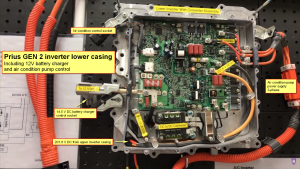
The control board utilizes the Blue Pill (link?) micro controller, and takes advantage of the OpenInverter.org software (link?) for control. It is also connected from the outside via the main (32 pin white) OEM connector - try to retrieve this connector and part of wiring loom when sourcing your inverter. Picture of connector further down in wiki.
The control board design incorporates the use of the existing inverter Current Sensors - if FOC option is to be used (Gen 2 Transaxle MG2), bandwidth should be a multiple of control loop frequency which is 8.8kHz. (link to how to modify original setup?)
Functionality of the existing resolver is integrated as well.
Assembly notes? Blue Pill programming notes or just links to Blue Pill section?
Try to get all the wiring harness bits that plug into the inverter when you purchase it. Else, the 32-pin connector inside the inverter part number is: 1318747-1, and the pins to wire it are: 1123343-1
Terminal Block Connection list (rough, in-progress):
Wire Connections
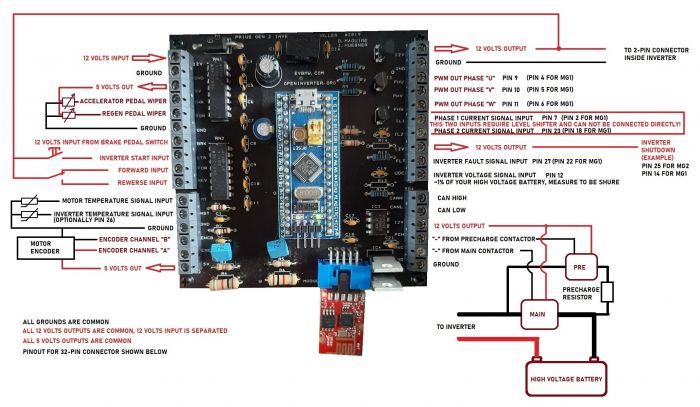
Control Board Pin mapping:
| Pin # | Designation | Description |
|---|---|---|
| TB1-1 | 12v-in | Primary 12v supply from ignition on |
| TB1-2 | GND | Primary ground connection to 12v negative. All grounds are common |
| TB1-3 | 5v VCC | 5V supply from board for use with throttle pot or hall pedal |
| TB1-4 | Throttle In | 0-5v variable voltage input from throttle pedal or pot |
| TB1-5 | Regen In | 0-5v variable voltage input. Can be used as second throttle channel or control regen from a brake pressure sensor |
| TB1-6 | GND | |
| TB1-7 | Brake In | 12v digital input from brake light switch. |
| TB1-8 | Start In | 12v digital input from "Start" position on a traditional ignition switch. Momentary action push button can be used. |
| TB1-9 | For In | 12v digital input commands motor to run in forward direction |
| TB1-10 | Rev In | 12v digital input commands motor to run in reverse direction |
| TB3-1 | +12v VCC | 12v output to inverter IGCT terminal (Not on the 32-pin connector, the red wire on the 2-pin connector next to it). |
| TB3-2 | GND | Common ground, but used to connect to inverter GND terminal (Not on the 32-pin connector, the black wire on 2-pin connector next to it). |
| TB3-3 | Phase U |
Phase U output. Connect to Inverter MUU terminal for MG2 inverter drive or GUU for MG1 inverter drive |
| TB3-4 | Phase Y | Phase V output. Connect to Inverter MVU terminal for MG2 inverter drive or GVU for MG1 inverter drive |
| TB3-5 | Phase W | Phase W output. Connect to Inverter MWU terminal for MG2 inverter drive or GWU for MG1 inverter drive |
| TB3-6 | Current U | Phase currents from inverter. Requires external divider circuit. Not required to run motor or inverter. |
| TB3-7 | Current Y | Phase currents from inverter. Requires external divider circuit. Not required to run motor or inverter. |
| TB3-8 | MG2 Enable | Connect to Inverter MSDN to run MG2 inverter or GSDN to run MG1 inverter |
| TB3-9 | MG2 Fault | Connect to MFIV for MG2 or GFIV for MG1 |
| TB3-10 | DC Bus | Connect to inverter VH to measure DC link voltage |
| TB2-1 | +5V VCC | 5v output to encoder for induction motor |
| TB2-2 | ENCA In | Encoder input A |
| TB2-3 | ENCB In | Encoder input B |
| TB2-4 | GND | Encoder ground |
| TB2-5 | HS Temp | Heatsink temp sensor input |
| TB2-6 | MOT Temp | Motor temp sensor input |
| TB4-1 | GND | Common ground |
| TB4-2 | Main Con | Main HV contactor control low side switch |
| TB4-3 | Precharge | HV precharge contactor control low side switch |
| TB4-4 | +12 V VCC | Spare 12v output |
| TB4-5 | CAN L | Can bus low signal |
| TB4-6 | CAN H | Can bus high signal |
New SMT control board with enclosure and designated pinouts
Please add pictures and description.
Pin Mapping - Note : Smaller 12-pin socket is the interface to the inverter & 20-pin to the motor
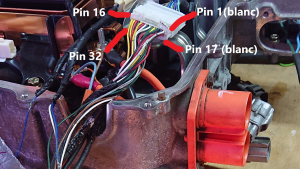
20 - Pin socket
Pin#01 - ENC_B/S3
Pin#02 - S1S4
Pin#03 - ENC_A/S2
Pin#04 - R1
Pin#05 - R2
Pin#06 - 5V
Pin#07 - THROTTLE 1
Pin#08 - THROTTLE 2
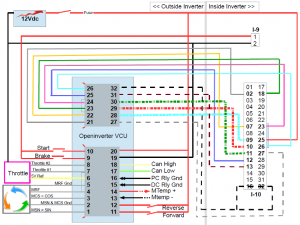
Pin#09 - START_IN (12V)
Pin#10 - BRAKE_IN (12V)
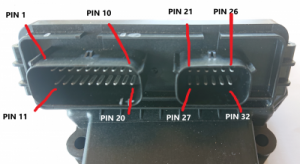
Pin#11 - FORWARD_IN (12V) (3 way switch)
Pin#12 - REVERSE_IN (12V) (3 way switch)
Pin#13 - MTEMP -
Pin#14 - MTEMP +
Pin#15 - DCSW_OUT (Ground signal)
Pin#16 - PRECARGE_OUT (Ground signal)
Pin#17 - CAN L
Pin#18 - CAN H
Pin#19 - GND
Pin#20 - 12V
12 - Pin socket ( starts at pin number #21) - Corresponding pin on Main White 32 pin Inverter connecter is in brackets.
Pin#21 - GIVA (2)
Pin#22 - MIVA (7)
Pin#23 - GIWA (18)
Pin#24 - MIWA (23)
Pin#25 - VH (12)
Pin#26 - MIVT (26)
Pin#27 - MFIV (27)
Pin#28 - MUU (9)
Pin#29 - MVU (10)
Pin#30 - MWU (11)
Pin#31 - CPWM (13)
Pin#32 - GINV/GCNV (16/32)
Connect MSDN Pin#25 in inverter (not 25 on controller) permanently to 12V to enable the MG2 Inverter
Connect CPWM to 12V via a 470 Ohm resistor for charge mode.
Connect the 2-pole white power connector (inside inveretr) to 12V and Ground to power up inverter electronics.
Initial Set up
Step 1 : Solder relevant (and included) connector pins to the Adapter Board
Step 2 : Plug in Wifi Adapter and connect ONLY Pin#19 - GROUND and Pin#20 - 12 Volts power supply
Confirm PWR LED lights up along with WIFI LED. Confirm ALIVE LED flashes.
Step 3 : Connect computer/laptop to the wifi network (Example - Inverter 7)
Step 4 : Go to search enginge (Google/Firefox etc) toolbar and type in 192.168.4.1 + Enter. (allow pop ups/Trusted site). Confirm Web based Interface appears and list of parameters appear.
If parameters appear, you are now connected to the Adapter board and the Web based Interface - Congratulations - You are now in the Matrix !
Software
The Control Board runs Open Inverter software. A set of known-good default inverter parameters can be found here: https://openinverter.org/wiki/Configuration_Files#Toyota_Prius_Gen2_Inverter
Do NOT program a deadtime value for the Gen2 inverter. It only uses 1 PWM per phase and the inverter itself generates a low-side and high-side signal WITH deadtime.